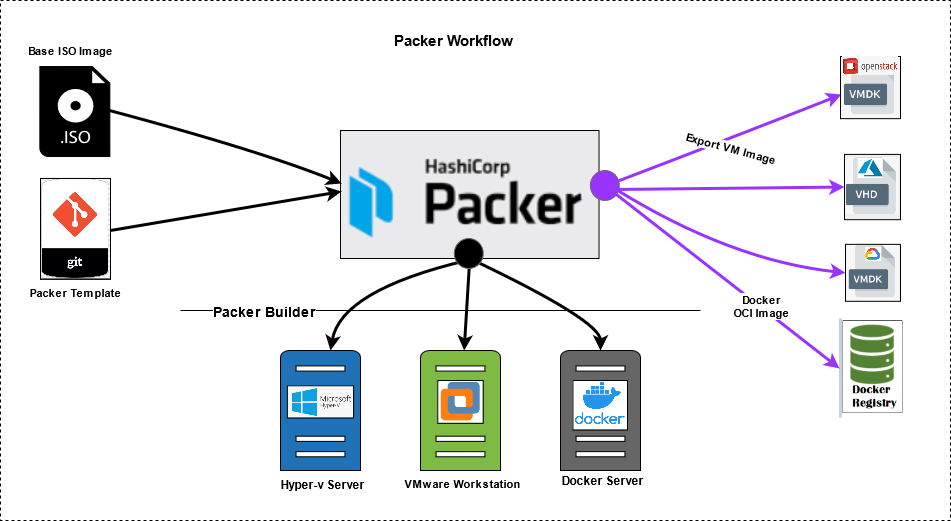Exploring HashiCorp Packer: The Open-Source Tool for Automated Machine Image Creation
In the fast-evolving landscape of infrastructure management, achieving consistency and automation is critical for efficient operations. HashiCorp Packer, an open-source tool, addresses these needs by enabling the creation of identical machine images for multiple platforms from a single source configuration. Whether you're managing cloud resources on AWS, Azure, or Google Cloud, or maintaining on-premises servers, Packer streamlines the process of building and maintaining standardized images, making it an indispensable tool in the DevOps toolkit.
What is HashiCorp Packer?
HashiCorp Packer is a lightweight, cross-platform tool developed by HashiCorp, designed to automate the creation of machine images. A machine image is a static unit containing a pre-configured operating system and installed software, used to quickly deploy new running machines. Packer allows you to define a template—written in HashiCorp Configuration Language (HCL) or JSON—that specifies the desired configuration. This template is then used to build identical images for various platforms, such as Amazon Machine Images (AMIs) for AWS, VHDs for Azure, or VMDKs for VMware.

Unlike configuration management tools like Chef or Puppet, Packer does not replace them but complements their functionality. During the image-building process, Packer can leverage these tools to install software and configure the image, ensuring a consistent starting point for your infrastructure.
Why is Packer Open Source?
Packer’s open-source nature, licensed under the Mozilla Public License 2.0 (MPL 2.0), fosters community engagement and transparency. While specific reasons for choosing this licensing model are not explicitly detailed in available resources, it seems likely that HashiCorp’s commitment to open source aligns with their mission to empower developers and organizations. The open-source model offers several benefits:
- Transparency: Users can inspect the source code to understand how Packer works and ensure it meets security and compliance needs.
- Community Contributions: Developers can contribute fixes, features, and plugins, enhancing Packer’s capabilities.
- Customization: Organizations can adapt Packer to their specific requirements, integrating it into unique workflows.
- Accessibility: Being freely available encourages widespread adoption across diverse teams and industries.
The Packer repository on GitHub (HashiCorp Packer GitHub) includes a CONTRIBUTING.md file, guiding users on how to contribute, further emphasizing its community-driven development.
Key Features and Capabilities
Packer is packed with features that make it a robust solution for image management:
- Cross-Platform Support: Create images for multiple platforms, including AWS, Azure, GCP, VirtualBox, and more, using a single template.
- Parallel Image Creation: Build images for different platforms simultaneously, significantly reducing build times.
- Plugin Ecosystem: Extend functionality with external plugins for builders (e.g., cloud providers), provisioners (e.g., Ansible, shell scripts), and post-processors. A comprehensive list of integrations is available on the HashiCorp Developer site.
- Integration with HashiCorp Tools: Seamlessly integrate with Terraform for provisioning infrastructure or HCP Packer for managing image metadata.
- Automation: Automate the creation of golden images—standardized, pre-configured images used across an organization.

These features make Packer highly performant and adaptable, capable of running on all major operating systems with minimal resource overhead.
Benefits of Using Packer
Incorporating Packer into your infrastructure management workflow offers several advantages:
- Standardization: Ensures all machines are configured identically, minimizing configuration drift and errors.
- Efficiency: Automates repetitive image-building tasks, saving time and reducing manual effort.
- Cost Savings: Optimizes resource usage in cloud environments by creating efficient, reusable images, potentially lowering costs.
- Scalability: Enables rapid scaling by generating new images on demand, supporting dynamic infrastructure needs.
These benefits are particularly valuable for organizations managing complex, hybrid cloud environments or those adopting infrastructure-as-code (IaC) practices.
Use Cases
Packer’s versatility makes it suitable for a variety of scenarios, including:
- Golden Image Creation: Create standardized images that serve as a baseline for deployments across an organization, ensuring consistency.
- Monthly VM Patching: Automate the process of updating and patching virtual machine images, integrating with CI/CD pipelines for regular maintenance.
- Immutable Infrastructure: Support immutable infrastructure models by creating images that are deployed as-is, reducing the risk of runtime configuration changes.
These use cases highlight Packer’s role in modern DevOps practices, particularly in environments prioritizing automation and consistency.
Getting Started with Packer
Starting with Packer is straightforward, with clear steps to set up and begin building images. Here’s a step-by-step guide:
- Install Packer:
- Download the latest version from the official Packer downloads page (Packer Downloads).
- Verify the installation by running
packer version.
- Create a Template:
- Define your image configuration in an HCL or JSON template. A basic template includes:
- Builders: Specify the platform (e.g.,
amazon-ebsfor AWS). - Provisioners: Define software installation steps (e.g., shell scripts, Ansible).
- Post-processors: Perform additional tasks, like compressing images.
- Builders: Specify the platform (e.g.,
- Define your image configuration in an HCL or JSON template. A basic template includes:
- Build an Image:
- Ensure credentials (e.g., AWS credentials in
~/.aws/credentials) are configured.
- Ensure credentials (e.g., AWS credentials in
- Use Reference Templates:
- Explore example templates on GitHub, such as those in the Packer Templates repository.
- Debugging and Testing:
- Use the
-debugflag for step-by-step execution:packer build -debug vm.pkr.hcl. - Test images for compliance using tools like Check Inspec (Inspec GitHub).
- Use the
Enable detailed logging with environment variables:
export PACKER_LOG=1
export PACKER_LOG_PATH="/path/to/packer.log"
Run packer build <template-file> to create the image. For example:
packer build vm.pkr.hcl
Example HCL template structure:
source "amazon-ebs" "example" {
access_key = "your_access_key"
secret_key = "your_secret_key"
region = "us-east-1"
source_ami = "ami-12345678"
instance_type = "t2.micro"
}
build {
sources = ["source.amazon-ebs.example"]
provisioner "shell" {
inline = ["sudo apt-get update", "sudo apt-get install -y nginx"]
}
}
For Linux users, use package managers or commands like:
wget -O- https://apt.releases.hashicorp.com/gpg | gpg --dearmor | sudo tee /usr/share/keyrings/hashicorp-archive-keyring.gpg
For hands-on learning, HashiCorp provides tutorials, such as:
- Building a Docker image locally without cloud resources.
- Creating an AWS AMI.
- Using HCP Packer with AWS and Terraform for advanced workflows.
Comprehensive documentation is available on the HashiCorp Developer site (Packer Documentation).
Community and Contributions
Packer benefits from a vibrant community that actively contributes to its development. The GitHub repository (HashiCorp Packer GitHub) serves as a hub for collaboration, where users can report issues, submit pull requests, or maintain plugins. The CONTRIBUTING.md file provides detailed guidelines for contributing, making it easy for developers to get involved.
Packer’s plugin ecosystem is a key strength, allowing users to extend functionality with custom builders, provisioners, and post-processors. For example, you can integrate Packer with new cloud providers or provisioning tools not natively supported. The HashiCorp Developer site lists available plugins, enabling users to tailor Packer to their needs.
Integration with HashiCorp Ecosystem
Packer integrates seamlessly with other HashiCorp tools, enhancing its utility in comprehensive IaC workflows:
- Terraform: Use Packer-built images as a foundation for Terraform-provisioned infrastructure, streamlining deployment pipelines.
- HCP Packer: A cloud-based registry that stores image metadata, enabling lifecycle management and compliance checks. HCP Packer tracks artifact versions and warns about outdated images, with advanced features available in the Plus tier.

This integration makes Packer a cornerstone of HashiCorp’s ecosystem, supporting end-to-end infrastructure automation.
Real-World Example
Consider a scenario where an organization needs to deploy a web application across AWS and Azure. Using Packer, they can:
- Define a single HCL template specifying the OS, web server (e.g., Nginx), and application code.
- Build AMIs for AWS and VHDs for Azure in parallel.
- Use Terraform to deploy instances from these images, ensuring identical configurations.
- Integrate with HCP Packer to track image versions and enforce compliance.
This workflow reduces manual configuration, ensures consistency, and accelerates deployment, demonstrating Packer’s practical value.
Table: Packer Components and Their Roles
| Component | Description | Example |
|---|---|---|
| Builder | Defines the platform and configuration for building the image. | amazon-ebs, azure-arm |
| Provisioner | Installs software or configures the image during the build process. | Shell script, Ansible, Chef |
| Post-Processor | Performs additional tasks after the image is built, like compression or upload. | Vagrant box creation, compression |
Conclusion
HashiCorp Packer is a versatile, open-source tool that simplifies and standardizes machine image creation, making it a vital component for modern infrastructure management. Its ability to automate image building, support multiple platforms, and integrate with tools like Terraform positions it as a cornerstone of DevOps practices. The open-source model fosters community collaboration, ensuring continuous improvement and adaptability.
Whether you’re creating golden images, automating VM patching, or building immutable infrastructure, Packer offers a robust solution to enhance efficiency and consistency. To dive deeper, explore the official documentation (Packer Documentation) or try the tutorials to build your first image. With Packer, you’re well-equipped to streamline your infrastructure workflows and embrace the power of automation.



